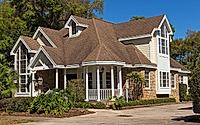Top 4 Components of a Modern Residential Roof System
For many homeowners, it’s always a seventh-heaven feeling once roofing work is completed and everything looks appealing. However, for roofing work to qualify as perfectly completed, it’s important to inspect all its major components after the work is done. Understanding what these components are and their purposes on the roof will make it easier for you, as the homeowner, to trace roofing problems when they arise. Below is a list of the top four components that make up a modern residential roof system.
Water and Ice Shields
If you live in rainy and cold areas above the snowline, you’ll always contend with two main roofing issues – water and ice damage. To curb this menace, your roofing installation company should add water and ice shields on/around potential problem areas on your roof. These areas include low-pitch roofs of 4/12, 3/12, and 2/12, roof valleys, and around penetrations.
When perfectly installed, these waterproof shields are responsible for preventing water and ice that get under your roofing materials from damaging your decking. Some states in the U.S. require that homeowners install ice and water shields along roof edges to prevent leaking. As such, it’s important to know whether such laws apply in your area before you install your roof.
Roof Sheathing (Decking)
A roof decking or sheathing is the perfect assortment of wooden materials, usually plywood or planks, that are laid as the foundation of your roofing system. These are mostly the last line of defense on your roofing, and more often, damage to the decking is always an indication that you need a roof replacement.
You could either choose plank or sheet decking depending on your budget and material availability. Sheet decking is much cheaper and could cost three times less than plank decking per square meter. The cost of installing roof decking also varies depending on the roofing codes in your area. If you’re required to install thicker sheathing materials, the cost will be higher and vice versa.
The Underlayment
A roofing underlayment is a material that your roofer installs between the roof decking and roofing material for an additional protection layer from the elements. Since roof decking is expensive to replace, the roof underlayment ensures that water or other elements that bypass your roofing material don’t destroy the decking.
Just like with sheathing, there are two underlayment options you could choose from synthetic and felt underlayment. For felt underlayment, you could go for the 30 lb heavy underlayment that’s less likely to tear and lasts longer. However, if you’re on a budget, the 15 lb option could work just fine for the shorter run. Synthetic underlayment is more durable than felt as it’s made of woven polypropylene or polyethylene, which easily repels water and holds on to nails.
Roof Vents
Venting allows for easy airflow in your house and attic, besides giving your home a generally modern and classy look. The main advantage of installing a vent is it maintains a seamless flow of air underneath your roof while keeping the internal roof components dry. With this active ‘respiration process’ your roof is kept free of mold formation and other common roof problems.
There are different types of vents you could settle for, including turbine vents, solar-powered vents, and ridge vents for an active ventilation system. However, if yours is a passive ventilation system, you may go for box vents, or gable-end vents, depending on your design taste and budget.
Knowing what components to prioritize in your modern roofing design can seem daunting, but that shouldn’t be the case now that you know the four crucial ones to include. Whether you’re building a new home from scratch or are replacing an old roof, these four components should surely feature on your roofing list.
- by Matt Watts







